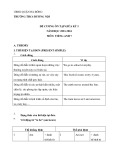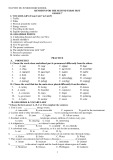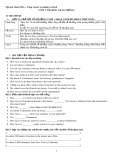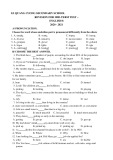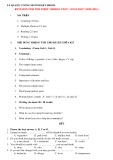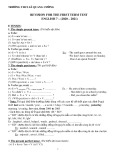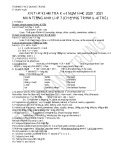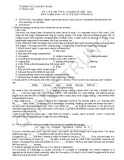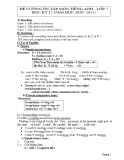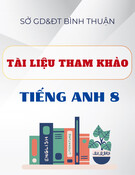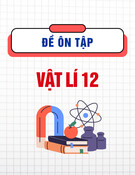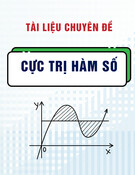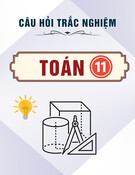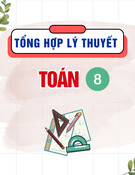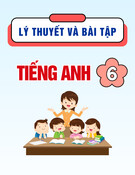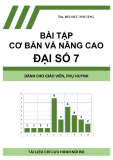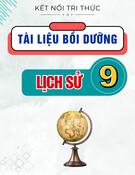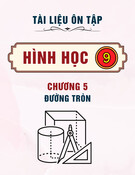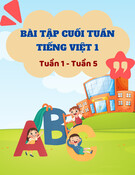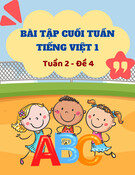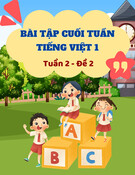ng THCS Thanh Quan
ườ Tr ọ H và tên: L p:ớ
Ề ƯƠ Ọ Ậ Ỳ Ế Đ C NG ÔN T P TI NG ANH H C K 1
I. VOCABULARY
Topic: from unit 1 to unit 6
II. PHONETICS
Phonetics from unit 1 to unit 6
Unit 1:
ə / / : away, answer, neighbour…
ɜː / /:burn, birth, hurt…
Unit 2:
/f/: fast, felt, food…
/v/: have, give, girl…
Unit 3:
/g/: girl, gold, green…
/k/: key, curl, coal…
Unit 4:
ʃ / / : condition, ocean, shy…
ʒ / /:measure, vision, usual…
Unit 5:
/ / ɒ : soft,hot, bottle…
/ :/ɔ :pork, sauce, fork…
Unit 6:
ʃ /t /: children, chair, question…
ʒ /d /: job, jeans, village…
III. GRAMMAR AND STRUCTURE
Ạ Ơ Ệ 1. THE PRESENT SIMPLE TENSE THÌ HI N T I Đ N
Công th c: ứ ộ Đ ng t ừ ườ th ng
Thể Công th cứ ẳ ị Kh ng đ nh
ủ ị Ph đ nh
Câu nghi v nấ
ả ờ ấ Tr l i câu nghi v n
ỏ ớ câu h i v i WHwords I/you/we/they +Vinf She/he/it +Vs/es I/you/we/they + do + not + Vinf She/he/it+ does + not + Vinf Do + I/you/we/they +Vinf ? Does + She/he/it + Vinf ? Yes, S + do/does No, S + do/does+not WH + do + I/you/we/they +Vinf? WH + does + She/he/it +Vinf?
To be:
Thể Công th cứ ẳ ị Kh ng đ nh
ủ ị Ph đ nh
Câu nghi v nấ
ả ờ ấ Tr l i câu nghi v n
ỏ ớ câu h i v i WHwords
I + am + C you/we/they +are + C She/he/it +is+ C I + am + not+ C you/we/they +are + not + C She/he/it +is + not + C Am + I + C? Are + you/we/they + C? Is+ She/he/it + C? Yes, I am you/we/they +are She/he/it +is No, I am + not you/we/they +are + not She/he/it +is + not WH + Am + I (+ C)? WH + Are + you/we/they (+ C)? WH + Is+ She/he/it (+ C)?
ậ ế ấ ệ t:
ườ ườ ng xuyên), often (th
ng xuyên), frequently (th ế ế ỉ
ườ ờ
Ạ Ệ Ế Ễ
D u hi u nh n bi ườ Adv: Always (luôn luôn), usually (th ng ế ả xuyên), sometimes (th nh tho ng), seldom (hi m khi), rarely (hi m khi), hardly (hi m khi) , ng xuyên), nowadays (ngày nay) never (không bao gi ), generally (nhìn chung), regularly (th … 2. THE PRESENT CONTINUOUS TENSE THÌ HI N T I TI P DI N Công th c:ứ ị ủ ị ẳ Câu kh ng đ nh Câu ph đ nh Câu h iỏ
ả ờ Am/ Is/ Are + S + Ving ? Tr l i: S + am/ is/ are + Ving CHÚ Ý: ạ ế S + am/ is/ are + not + V ingCHÚ Ý: – am not: không có d ng vi t
– S = I + am tắ t Yes, I am. – Yes, he/ she/ it + is. – Yes, we/ you/ they + are. – S = He/ She/ It + is – is not = isn’t
– S = We/ You/ They + are – are not = aren’t
No, I + am not. – No, he/ she/ it + isn’t. – No, we/ you/ they + aren’t. ộ ử ụ trong i ti p ấ ừ “tobe” lên ễ ầ ầ ộ ừ ồ ộ “tobe” r i c ng đ ng ỉ ệ ả ướ ố ớ ===> Đ i v i câu nghi v n, ta ộ ch vi c đ o đ ng t ủ ữ c ch ng . tr ủ ị ố ớ ===> Đ i v i câu ph đ nh ủ ễ ệ ạ ế c a thì hi n t i ti p di n, ta ỉ ầ ch c n thêm “not” vào sau ộ ộ đ ng t ừ đuôi “–ing”. t Ví d :ụ Ví d :ụ ừ ấ ===> Ta th y đ ng t ệ ạ ế câu s d ng thì hi n t ả di n c n ph i có hai thành ừ “tobe” và “V ph n là: đ ng t ủ ữ ừ ớ ing”. V i tùy t ng ch ng mà ừ ộ đ ng t “to be” có cách chia khác nhau.
Ví d :ụ
a) Are you doing your homework? Yes, I am./ No, I am not.
b) Is he going out with you? Yes, he is./ No, he isn’t.
a) I am not listening to music at the moment. b) My sister isn’t working now. c) They aren’t watching the TV at present. a) They are watching TV now. b) She is cooking with her mother. c) We are studying English. c) Are they studying English? Yes, they are./ No, they aren't.
ệ ấ ậ ế D u hi u nh n bi t:
ừ ỉ ờ ạ Tr ng t ch th i gian: ệ ạ i
ờ ụ ể + now (It’s 12 o’lock now)
ộ ừ
Trong câu có các đ ng t nh :ư
Now: Bây giờ Right now: Ngay bây giờ At the moment: Ngay lúc này At present: Hi n t It’s + gi c th Look!/ Watch! (Nhìn kìa!) Listen! (Nghe này!) Keep silent! (Hãy im l ng)ặ Watch out! = Look out! (Coi ch ng)ừ
ƯƠ Ơ NG LAI Đ N
3. THE FUTURE SIMPLE TENSE THÌ T Công th c: ứ
Thể Công th cứ
ẳ ị Kh ng đ nh S + will/shall + Vinf
ủ ị Ph đ nh S + will/shall + not+ Vinf
Câu nghi v nấ Will/shall + S + Vinf?
ả ờ ấ Tr l i câu nghi v n
ỏ ớ câu h i v i WHwords Yes, S + will/shall. No, S + will/shall + not WH + will + S +Vinf?
ấ ệ ế ậ t:
ớ ộ ươ D u hi u nh n bi tomorrow (ngày mai), soon (s m), someday (m t ngày nào đó), in the future(trong t ng lai)
Ứ Ơ THÌ QUÁ KH Đ N
Next + Ntime: next year, next weekend…. 4. THE PAST TENSE Công th c: ứ ộ Đ ng t ừ ườ th ng
Thể Công th cứ
ẳ ị Kh ng đ nh S +Ved/c2
ủ ị Ph đ nh S + did + not + Vinf
Câu nghi v nấ Did + S + Vinf ?
ả ờ ấ Tr l i câu nghi v n
ỏ ớ câu h i v i WHwords Yes, S + did No, S + didn’t WH + did + S +Vinf?
To be:
Thể Công th cứ
ẳ ị Kh ng đ nh
ủ ị Ph đ nh
Câu nghi v nấ
ả ờ ấ Tr l i câu nghi v n
ỏ ớ câu h i v i WHwords I /she/he/it + was + C you/we/they +were + C I /she/he/it + was + not+ C you/we/they +were + not + C Was +I/ she/he/it + C? Were + you/we/they + C? Yes, I/She/he/it + was you/we/they +were No, I/she/he/it + wasn’t you/we/they +weren’t WH + was +I/ She/he/it (+ C)? were + you/we/they (+ C)?
ậ ế ấ ệ t:
ướ ướ c đây): c, tr two years ago….., in the past (trong quá
ứ Ệ Ạ
D u hi u nh n bi yesterday (ngày hôm qua), ago (tr kh )ứ last + Ntime: last year……, in + năm trong quá kh : in 1975, in 1998… 5. THE PRESENT PERFECT TENSE THÌ HI N T I HOÀN THÀNH Công th c: ứ
Thể Công th cứ
ẳ ị Kh ng đ nh
ủ ị Ph đ nh
Câu nghi v nấ
ả ờ ấ Tr l i câu nghi v n
I /you/we/they +have + Vpp She/he/it +has+ Vpp I /you/we/they +have + not + Vpp She/he/it +has+ not + Vpp Have + I /you/we/they + Vpp? Has+ she/he/it + Vpp? Yes, I /you/we/they +have She/he/it +has No, I /you/we/they +have not She/he/it +has not
ỏ ớ câu h i v i WHwords WH + have + I/ you/we/they +Vpp? WH + has+ she/he/it + Vpp ?
ấ ệ
ồ ớ ờ ờ ừ ừ , đã t ng), just( v a m i), already (đã r i)
ờ ờ ư ố ả ầ ỏ ư ủ ị
ớ ờ i bây gi
ằ
S + tobe + as + adj + as + Pronoun/clause ằ
ố
Ừ Ế ƯỢ DANH T Đ M Đ C VÀ DANH
ƯỢ Ừ Ế D u hi u: never: (ch a bao gi ), ever (có bao gi since + m c th i gian (since 2000, since last summer ) for + kho ng th i gian (for a week, for two years) recently, lately: g n đây yet: ch a(dùng trong câu ph đ nh và câu h i) ề ầ many times, several times: nhi u l n once, twice, three times….. so far, up to now, up to the present, until now: cho t this is the first/second/third…. 6. COMPARISONS: 6.1. So sánh b ng : S + tobe + not + as/so + adj + as + Pronoun/clause 6.2. So sánh không b ng : S + tobe + the same as + Pronoun/clause 6.3. So sánh gi ng nhau : 6.4. So sánh khác nhau : S + tobe+ different from + Pronoun/clause 7. COUNTABLE AND UNCOUNTABLE NOUNS C T KHÔNG Đ M Đ
ừ ế ượ c
ể ế ượ ố ượ c s l ng.
ể ố ộ ừ ế không đ m đ ụ ể ng c th
đ m đ 7.1. Danh t – Là nh ngữ danh từ có th đ m đ Ex: girl, picture, cat, chair, tree, apple danh từ s ít m t mình. (a girl, two eggs…) Chú ý: chúng ta không th dùng ượ c 7.2. Danh t Là nh ngữ danh từ không th đ m đ ượ ố ượ ể ế c s l Ex: music, rice, money, bread, gold, blood……… A bottle of…/ a pinch of…/ a kilof of…/ a piece of…/ a glass of…/ a bag of…/ a bar of…
ị ớ ồ ẳ ề ướ c đó ộ ý đ ng tình v i m t đi u kh ng đ nh tr ượ ườ ể ễ ả cu i câu. c dùng đ di n t ứ ở ố ng đ ng
ủ ị ề ủ ị ể ồ ớ c ướ ầ ử ụ ồ ọ ộ cu i câu và trong câu đ ng tình rút g n chúng ta c n s d ng các tr ợ ừ ở ạ d ng ph đ nh.
ể ỏ ố ượ ng
ượ 8. TOO / EITHER 8.1.“Too” đ và "too" th Ex: Tom is interested in dancing, and Kate is, too. 8.2.“Either” dùng trong câu ph đ nh và đ đ ng tình v i m t đi u ph đ nh tr ứ ở ố đó. “Either” cũng đ ng ủ ị ộ đ ng t Ex: My sister doesn't know the name of that singer and I don't, either. 9. HOW MUCH / HOW MANY “How much”, “How many” dùng đ h i s l .How much: 9.1 Ex: How much milk do you want? ế HOW MUCH + Noun (không đ m đ c)
*công th c:ứ
ừ ế ượ ủ ể ỏ ố ượ ng c a danh t không đ m đ c
ế
*cách dùng:dùng đ h i s l .How many: 9.2 Ex: 1. How many eggs do we have? ượ ố HOW MANY + Noun (đ m đ c s nhi u)ề
*công th c:ứ
ượ ừ ế ể ỏ ố ượ c ng c a danh t
ở ư Noun sau How many luôn ủ đ m đ ề ứ ố hình th c s nhi u
ế ượ ừ ố ượ c .
ụ
ầ ừ ữ ằ ữ ứ s ít đ m đ c ph âm : a cat, a dog, a table ướ c nguyên âm ( nguyên âm là nh ng ch cái b ng đ u t u,e, o,a,i : an
ộ ả ề
ế ể ượ ừ ế ượ ố ề c và danh t đ m đ c s nhi u.
ị ượ ớ ẳ không đ m đ ừ c dùng trong câu kh ng đ nh.
ỏ ự ể ờ ị i m i l ch s
ề
ừ ế ế ớ ượ ố ề đ m đ c s nhi u
ượ c và danh t ỏ không đ m đ ủ ị ượ ừ c dùng trong câu ph đ nh và câu h i.
ể ỉ ộ ố ượ ượ ữ ớ ơ c dùng đ ch m t s l ớ ứ ng l n h n so v i th
ề ữ ủ ề ấ ấ ầ ộ ơ
ượ ơ ơ
ườ ơ ủ ậ ng này có ít xe môtô h n. ả ờ
*cách dùng:dùng đ h i s l *l u ý: 10. A/AN/SOME/ANY 10.1. “a” và “an” c dùng cho danh t đ ướ ứ “a” đ ng tr “an” đ ng tr ocean, an orange, an apple…) 10.2.“some” và “any” Ý nghĩa: C “some” và “any” đ u có nghĩa là “m t vài” Cách dùng *Some: Chúng ta có th dùng “some” v i danh t “Some” đ Ex: Tom gave me some oranges. Ngoài ra chúng ta cũng có th dùng “some” trong: ờ + câu h i mang ý nghĩa l Ex: Do you need some paper to write on? Would you like some potatoes? ị + câu đ ngh Ex: Can I have some apples, please? *Any: Chúng ta dùng any v i danh t “Any” đ Ex: Do you have any ideas for this problem? 11. MORE/LESS ề ơ 11.1. more (nhi u h n, thêm n a) đ khác. Ex: She can’t afford to buy this fax machine. She needs more money. ộ Cô y không đ ti n mua máy fax đó. Cô y c n thêm m t ít ti n n a. ạ Ex: Have some more butter. B n dùng thêm m t ít b nhé. ạ ả ơ Yes, I will. Thanks. Vâng. C m n b n. ể ỉ ố ượ 11.2. less: đ ng ít h n, kém h n. c dùng đ ch s l Ex: There are fewer motorbikes on the road. Trên đ I have less free time on Sunday. Vào Ch nh t tôi ít có th i gian r nh. 12. COMPOUND SENTENCE CÂU GHÉP
ộ c n i b ng: ẩ ấ ặ ẩ
ừ ộ ấ c đ t tr , có m t d u ph y đ
ả k t qu , trong đó Clause 2 là k t qu c a Clause 1.
ỉ ậ ế ấ ấ ượ ả ủ ọ t qua
ọ ễ ả ự ự s l a ch n.
ừ ạ ố
ệ ơ h n.)
ễ ả ự ố ậ ủ s đ i l p c a Clause 2 và Clause 1.
ậ ớ ư ẫ
ờ .)
ễ ả ự ệ s li t kê.
ơ
ạ ộ ườ ế ng đ n câu l c b ghita)
ế ẫ nguyên nhân, trong đó Clause 2 là nguyên nhân d n đ n Clause 1 ượ ố ằ M t câu ghép đ ấ 1) a semicolon or colon (d u ph y ho c ch m ph y) Ex: I met David yesterday, he’s just come out of hospital. 2) a coordinating conjunction, Ex: “and”, “but”, “so”, “or”; sometimes preceded by a comma. ừ ẩ ượ ặ ướ (Liên t c liên t ) Ex: Children do more exercise than adults, so they are more active. so: vì v yậ *Form : Clause 1, so + Clause 2 ễ ả ế *Usage: di n t Ex: She learned hard, so she passed the exam. (Cô y h c chăm ch , vì v y cô y v ỳ k thi) or: ho cặ *Form: Clause 1, or + Clause 2 *Usage: di n t ặ Ex: You should stop smoking, or your health will be worse. (B n nên ng ng hút thu c ho c ỏ ủ ạ ẽ ở ứ s c kh e c a b n s tr nên t but: nh ngư *Form: Clause 1, but + Clause 2 *Usage: di n t Ex: He got up early, but he couldn’t come on time. (Anh ta đã d y s m, nh ng anh ta v n ể ế không th đ n đúng gi and: và *Form: Clause 1, and + Clause 2 *Usage: di n t Ex: I like playing the guitar, and I often go to the guitar club. (Tôi thích ch i ghita và tôi th because: b i vìở *Form: Clause 1+ because + Clause 2 Because + Clause 2, Clause 1 *Usage: di n t
ễ ả Ex: I like her. She is kind. I like her because she is kind. / Because she is kind, I like her.
ấ ố
ấ (Tôi thích cô y vì cô y t ề ứ t, tôi thích cô y) ế ộ ấ ấ ệ ế ệ ề ả
ấ ố t. / Vì cô y t L u ýư : N u m nh đ ch a “because” đ ng đ u câu thì h t m nh đ đó ph i có m t d u ầ ứ ph y.ẩ Ừ Ể Ỏ 13. QUESTION WORDS T Đ H I
ườ i (ng ụ ườ ạ ấ ớ i cao nh t l p b n?)
ủ ữ ụ
ứ Who: Ai ủ ể ể ỏ ề ườ ứ i là ch th ) Ch c năng: Dùng đ h i v ng Ví d : Who’s the tallest student in your class? (Ai là ng Whose: C a aiủ ể ỏ ề ự ở ữ Dùng đ h i v s s h u Ví d : Whose are these shoes? (Nh ng đôi giày này là c a ai) What: Cái gì Ch c năng:
ứ
ể ề ộ ậ ể ỏ ộ Dùng đ h i thông tin v m t th gì đó H i m t ai đó đ xác nh n thông tin
ạ ấ ạ
ể
ứ ể ỏ ề ậ ạ ế ụ
ể ỏ ề ờ ạ ẽ ề
đâuỞ ể ỏ ề ị ể ị ạ ố ụ ở đâu?)
ạ ơ
ạ ể ỏ ề ạ ạ ạ ế i mua chi c váy này?)
ạ
ờ ợ ể ư ♦ ♦ ỏ Ví d :ụ What are you doing? (B n đang làm gì đ y) What’s your name? (Tên b n là gì) What for: Đ làm gì Ch c năng: +Dùng đ h i v lý do, nguyên nhân Ví d : What made you do that for (Cái gì khi n b n làm v y?) When: Khi nào +Dùng đ h i v th i gian ụ Ví d : When will you comeback home? (Khi nào b n s v nhà?) Where: +Dùng đ h i v đ a đi m, v trí Ví d : Where do you live? (B n s ng Which: Cái nào ọ ể ỏ ề ự ự +Dùng đ h i v s l a ch n Ví du: Which pen do you like? (B n thích cái bút nào h n?) Why: T i sao Dùng đ h i v lý do, nguyên nhân Why do you buy this skirt? (T i sao b n l Why don’t: T i sao không +Dùng đ đ a ra l i g i ý ạ ạ ố ớ i nay v i
Why don’t you go out tonight with us? (T i sao b n không đi ra ngoài t t ?)ớ
ặ ủ ứ ư ủ ể How are you? (B n ạ ỏ
ả ả ủ ạ nhà đ n tr ng c a b n là bao xa
ạ ẽ ấ ụ ệ
ể Ừ Ỉ Ự Ộ
ừ ỉ ự ổ ế ch s thích và ghét ph bi n
ư ế How: Nh th nào ể ỏ ề Dùng đ h i v cách th c, đ c tính cũng nh tính cách c a ch th . VD: có kh e không?) How far: Bao xa ể ỏ ề Dùng đ h i v kho ng cách. VD : How far is it from your house to your school? Kho ng cách ườ ế ừ t How long: Bao lâu ể ỏ ề ờ Dùng đ h i v th i gian How long will you finish the task? B n s m t bao lâu đ hoàn thành nhi m v này? 14. VERBS OF LIKING AND DISLIKING Đ NG T CH S THÍCH VÀ GHÉT ộ 14.1.Các đ ng t ộ ừ ỉ ự 1. Đ ng t ch s yêu, thích: like, love, enjoy, fancy, adore ộ ừ ỉ ự 2. Đ ng t ch s ghét, không thích: dislike, hate, detest 14.2. Công th c:ứ (cid:0) (cid:0) like/love/enjoy/fancy/adore + Ving dislike/hate/detest + Ving
ậ ườ thích tr ng hoa trong v n.)
Ị Ộ Ex: ạ Do you like listening to music? (C u có thích nghe nh c không?) ồ ẹ ớ My mother loves planting flowers in the garden. (M t PASSIVE VOICE – CÂU B Đ NG 15.
ị ộ ở ệ ạ ơ Câu b đ ng i đ n:
thì hi n t Thể Công th cứ ẳ ị Kh ng đ nh
ủ ị Ph đ nh
Câu nghi v nấ
ả ờ ấ Tr l i câu nghi v n
ỏ ớ câu h i v i WHwords
I am + P2… He/ She / It + is + P2… You / We / They + are + P2… I am + not + P2… He/ She / It + is + not + P2… You / We / They + are + not + P2… Am I + P2…? Is + he/ She / It + P2…? Are + you / We / They + P2…? Yes, I am He/she/it + is you/we/they + are No, I am not He/she/it + is not you/we/they + are not WH + am I + P2…? is + he/ She / It + P2…? are + you / We / They + P2…?
ị ộ ở ứ ơ Câu b đ ng thì quá kh đ n:
Thể Công th cứ ẳ ị Kh ng đ nh
ủ ị Ph đ nh
Câu nghi v nấ
ả ờ ấ Tr l i câu nghi v n
ỏ ớ câu h i v i WHwords
I was + P2… He/ She / It + was + P2… You / We / They + were + P2… I was + not + P2… He/ She / It + was + not + P2… You / We / They + were + not + P2… Was I + P2…? Was + he/ She / It + P2…? Were+ you / We / They + P2…? Yes, I was He/she/it + was you/we/they + were No, I was not He/she/it + was not you/we/they + were not WH + was I + P2…? was + he/ She / It + P2…? were+ you / We / They + P2…?
Ạ IV.TYPES OF EXERCISES – CÁC D NG BÀI
1. Circle the letter A, B, C or D to indicate the word whose underlined part is pronounced
differently from the others
2. Circle the letter A, B, C, or D to indicate the word whose main stress pattern is placed
differently from the others
3. Circle the letter A,B,C, or D to indicate the underlined part that needs correction and correct it
4. Circle the best answer to complete the sentence 5. Circle the letter A, B, C or D to indicate the word(s) CLOSEST in meaning to the underlined word(s)
6. Circle the letter A, B, C or D to indicate the word(s) OPPOSITE in meaning to the underlined word(s)
7. Fill in the blank with one given word to complete the passage 8. Read the passage then answer the questions 9. Read the passage then decide if the statements are true (T) or false (F) 10. Read the passage then choose the best answer 11. Rewrite the sentence without changing the meaning of the root one 12. Rearrange the words to make a meaningful sentence 13. Make questions for the underlined words or phrases 14. Write full sentences using the suggested words and phrases given 15. Listen then fill in the blank 16. Listen then decide if the statements are true (T) or false (F) 17. Listen then match 18. Listen then choose the best answer 19. Speaking:
Topic: from unit 1 to unit 6
Ộ Ố Ả Ậ V. EXERCISES – M T S BÀI T P THAM KH O:
1. Circle the letter A, B, C or D to indicate the word whose underlined part is pronounced differently from the others: A. population B. volunteer D. provide C. offer 1.
2. A. tutor B. volunteer C. computer D. community
3. A. certain B. compare C. encourage D. community
4. A. charity B. chemistry C. chemical D. mechanic
5.
A. calories B. actor C. grafity D. gallery
A. seaside A. of A. page A. begun C. combine C. leaf C. go C. sun B. police B. fan B. game B. funny D. hygiene D. half D. gift D. autumn
6. 7. 8. 9. 10. A. bird B. collect C. burn D. serve
11. A. bear B. hear C. dear D. near
12. A. mother B. some C. cold D. come
13. A.absent B. government C. dependent D. enjoy
14. A. talk B. walk C. fall D. sale
15. A. sometimes B. season C. song D. sugar
16. A. walked B. worked C. painted D. washed
17.A. tofu B. forest C. role D. fold
18. A. bought B. brought C. thought D. though
19. A. bird 20. A. burn B. girl B. sun C. first C. hurt D. sister D. turn
2. Circle the letter A, B, C, or D to indicate the word whose main stress pattern is placed differently from the others :
1. 2. 3. 4. 5. A. donate A. volunteer A. statistic A. provide A. elderly B. rubbish B. community B. environment B. mentor B. encourage C. centre C. engineer C. community C. labour C. benefit D. money D. independent D. government D. tutor D. interview
6. A. advertisement C. charitable
7. A. tofu 8. A. recipe 9. A. fragrant 10. A. compose
B. benefit B. spicy B. turmeric B. unique B. sausage C.tasty C. tuna C. unusual C. donate
11. A. anthem 12. A. control 13. A. photography 14. A.curriculum 15. A.sculpture 16. A. benefit 17. A.interview 18. A.volunteer 19. A. tutor 20. A. university
B. gallery B. opera B. perform B. anthem B. support B. service B. mentor B. community B. teacher B. establish C. compose C. puppet C. atmosphere C. support C. perform C. traffic C. support C. graffiti C. pagoda C. professor D. interview D. unique D. delicious D. obesity D. control D. atmosphere D. rural D. originate D. performance D. curriculum D. composer D. service D. performance D. study D. imperial
3. Choose the best answer: 1. He loves _____________ tree leaves from different countries. A. collecting C. collect D. collects B. to collect 2. My dad enjoys ________ his bike to work. A. to ride C. rides D. riding B. ride 3. I love cooking, _________ my sister doesn’t. A. because B. so C. but D. and
4. Laughing is good_________ your health. B. to A. for C. with D. of
5. Choose the word that has the underlined part pronounced /3:/ B. pear C. earn A. dear D. heart
I find carve eggshells boring because it takes a lot of time to complete one shell.
C. listening D. listened
B. but C. so D. and
D. stomachache B. sunburn
D. fewer C. much B. less
B. think D. tell 6. Choose one mistake and correct it. 7. All of us enjoy ………………. to classical music. A. listen B. listens 8. The Japanese eat a lot of rice, …………. they eat a lot of fish, too. A. or 9. Hoa looks red. She was outdoors yesterday. Perhaps she has _______ A. flu C. spots 10. My family has decided to use _________ electricity by using more solar energy instead. A. more 11. I ............... playing board games interesting because I can play them with my friends. A. find C. say 12. I …………….. Nha Trang when I was a child. A. visit B. visited C. will visit D. have visited
13. Is there ………. orange juice in the fridge? B. a A. some C. an D. any 14. There isn’t……………. water left. A. a C. some D. any
A. a C. some D. any
B. an 15. Do you have ………… eggs to make this cake? B. an 4.Complete the passage with the words given: bought competition singing there on English
Mary’s hobby is singing. She enjoys (1) ………… very much. When her brother (2) ……… a karaoke set last month, Mary was so glad that she sang every day after dinner. She likes to sing only (3) …………… songs. In fact, she has already sung all the songs found (4) …… the karaoke discs. Mary is singing in the karaoke (5) ………… organized by the RC Center this Saturday. Her family is going (6) …… to support her. 5. Put a word from the box in each gap to complete the following passage
In the United States, almost everyone, at one time or another, has been a (1) ______________. According to U.S. government statistics, about onefifth of the American (2) ______________ does volunteer work each year. Americans have had the tradition of volunteering and (3) ______________ one another since the early days of the country.
American volunteer not because they are forced or paid to (4) ______________ it. They (5) ______________ it! Traditional volunteer activities include (6) ______________ money for people in need , cooking and (7) ______________ food , doing general labour [such as cleanup (8) ______________ and home repair], providing transportation [such as giving ride to the (9) ______________], and tutoring/ (10) ______________ young people.
6. Read the passage then answer the questions:
Eating habits in Viet Nam
Meals in Viet Nam lunch or dinner must include rice. Traditionally, Vietnamese meals
are prepared by wives or mothers and the whole family is expected to eat. However, families now may have only one meal a day at home, and it may not include all the family members. Tastes, cooking methods and dishes are different between the three regions: the North,the Central, and the South. Nowadays, these differences have become small. Sine Viet Nam opened it doors to foreign investors, more foreigners have stayed and
worked in Viet Nam. As a result, more foreign restaurent have been opened in Viet Nam, especially in big cities. Young people in Viet Nam now like fast food because of its conveniences. Vietnamese
food fast shops have been opened, and the most successful Vietnamese fast food chain is Pho 24. in recent years, there have been more Vietnamese fast food chains such as Bun Bo Hue 3A 3 1. What do meals in Viet Nam usually includes?............................................................................. ……………………………………………………………………………………………………… 2. When have more foreign restaurants been opened in Viet Nam?................................................ ……………………………………………………………………………………………………… 3. Why do young peoplę in Viet Nam like fast food?...................................................................... ……………………………………………………………………………………………………… 4. Where do most employees have lunch?....................................................................................... ……………………………………………………………………………………………………… 5. What is the most successful Vietnamese fast food chain?............................................................ ……………………………………………………………………………………………………… 7. Read the passage then answer the questions: The first reason why many families do volunteer work is that they feel satisfied and proud. The feeling of fulfillment comes from helping the community and other people. In addition, volunteering is a great way for families to have fun and closer. But many people say they don’t have time to volunteer because they have to work and take of their families. If that’s the case, try rethinking some of your free time as a family. You could select just one or two projects a year and make them a family tradition. For instance, your family can make and donate gift blankets for the old homeless people on holidays. Your family can also spend only one Saturday morning a month collecting rubbish in your neighborhood. 1. How do people often feel when they volunteer?.......................................................................... ……………………………………………………………………………………………………… 2. Why don’t some people have time to volunteer?.................................................................... ……………………………………………………………………………………………………… 3. How can your family help the old homeless people?................................................................. ……………………………………………………………………………………… 8. Choose the best answer to complete the passage:
Headache is a very common disease. The symptoms (1)…….. a headache are various. People may (2)……….. pains only one side of the head. Sometimes when the pain goes away, the head is sore. People have a headache (3) …………. they work too hard or they are too nervous about something. (4)……….. can help cure the disease but people usually have to do more than taking tablets. They can prevent headaches by changing their diets or their (5) …………… or simply by going to bed. 1. 2. 3. 4. 5. A. on A. be A. when A. Medicine A. life B. in B. have B. but B. Doctor B. lifestyles D. at D. take D. and D. Fruit D. working C. of C. happen C. so C. Sport C. hobbies
9. Rearrange these words/ phrases into the meaning sentences: 1. sunburn / yesterday / was / because / outside / has / Alice / she / all / day / . …………………………………………………………………………………………….. 2. and / difficult / boring / that / eggshells / people / carving / Some / say / is /. .... ………………………………………………………………………………………….. 3. girl / have / is / the / kindhearted / She / most / ever / I / met / . …………………………………………………………………………………………….. 4. organization / the / to / encouraged / people / Big Heart / has / protect / environment/ . …………………………………………………………………………………………….. 5. you/ have/ finished/ homework/ your/ yet / ? …………………………………………………………………………………………….. 6. poor / money / should / the / We / raise / for / . …………………………………………………………………………………………….. 10.Write full sentences using the suggested words and phrases given: 1.Tuan / find / play / table tennis / interesting / because / he / can / play / best friends/ . ……………………………………………………………………………………………. 2.They / visited / Ho Chi Minh City / so far /. ……………………………………………………………………………………………. 3.Lan / like / talk / to / her friends / her free time /. …………………………………………………………………………………………… 4. They / donate/ books/ clothes/ poor children / five years /. ……………………………………………………………………………………………. 5. How many / students / in / class / ? ……………………………………………………………………………………………. 11.Complete each sentence so it means the same as the sentence above: 1. I didn’t go to school because I was sick. (so) I was sick, …………………………………………………………………………… 2.It will be good if you eat less meat and more vegetables. (should) You ………..…………………………………………………………………………. 3. He likes playing computer games in his free time. His hobby is ……………………………………………………………………….… 4. I am interested in watching TV in the evening. (enjoy) ……… ……………………………………………………………………………….. 5.I think that learning English is important. (find) I ……………………………………………………………………………………….. 6.The painting is bigger than the photograph.( not as……as) >………………………………………………………………………………………….. 7. Playing volleyball is more interesting than watching TV.( not as……..as) >………………………………………………………………………………………….. 8. This picture is the same as the picture in our room. ( not different from) >………………………………………………………………………………………….. 9. Her book is not the same as my book. ( different from) >…………………………………………………………………………………………… 12. Combine each pair of the following sentences into one, using the suggested conjunctions in the brackets:
1. Mr. Hai usually has stomach problems. He eats dinner very close to the bedtime. (so) =>…………………………………………………………………………………………. 2. My dad has a lot of carved eggs. He has never sold any of them. (but) =>…………………………………………………………………………………………. 3. You will get a breathing problem. Clean your bed room more regularly. (or) =>…………………………………………………………………………………………. 4. I feel tired. I feel weak. (and) =>………………………………………………………………………………………….. 13. Make questions for the underlined words or phrases: 1. There is one cake on the table. =>…………………………………………………………………………………………. 2. I have some bread in my bag. =>…………………………………………………………………………………………. 3. I went to that museum last month. =>…………………………………………………………………………………………. 4. They volunteer because it makes a diference. =>…………………………………………………………………………………………. 14. Change these sentencs into passive voice: 1. They sell tickets at the gate of the tourist site.
=> Tickets…………………………………………………………………………
2. People grow a lot of flowers in Da Lat.
=> A lot of flowers…………………………………………………………………
3. Tourists can buy many kinds of goods in Ben Thanh Market.
=> Many kinds…………………………………………………………………….
4. They built Tan Ky House two centuries ago.
=> Tan Ky House………………………………………………………………….
5. My father took us to school yesterday.
=> We……………………………………………………………………………..






